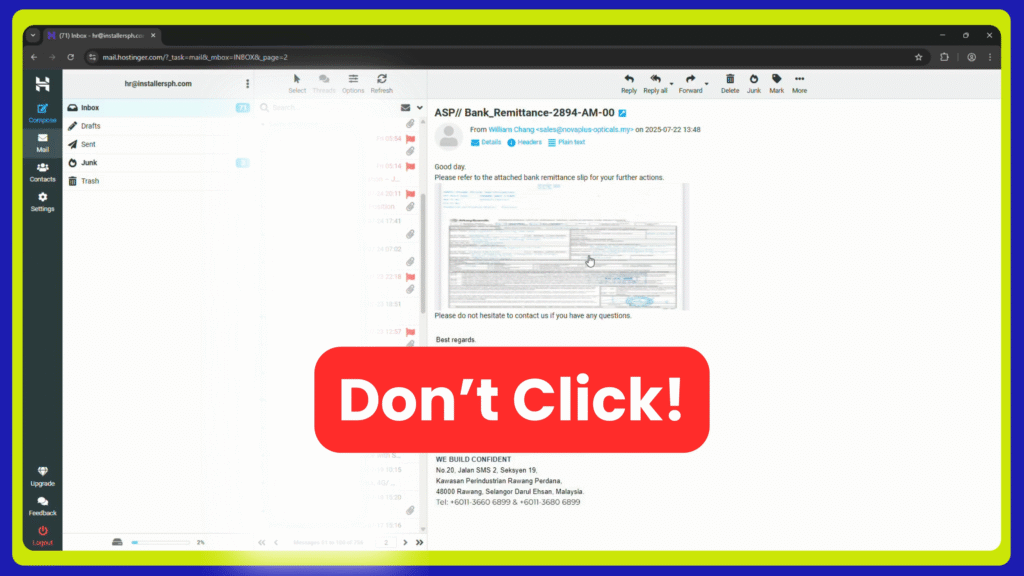AccessPoint Supply and Installation at Santo Niño Village-Final Progress Update. Introduction. Reliable wireless connectivity is essential in today’s homes, supporting daily communication, work, and entertainment needs. To ensure stable and extended network …
Awareness Video about
Phishing Emails.

Introduction
In today’s hyper-connected digital environment, phishing emails remain one of the most prevalent and dangerous cyber threats. Despite increasing awareness about cybersecurity, phishing still accounts for a large portion of online scams and data breaches across the globe. With just one click on a malicious link, a single user can compromise an entire organization’s data integrity. That’s why awareness is more important than ever.
To address this threat, our team launched an Awareness Video about Phishing Emails, designed to educate users on how to detect, avoid, and respond to phishing attempts. This video, narrated with a calm but alert tone, walks viewers through common red flags and best practices for handling suspicious emails. In this article, we will delve deeper into the concepts covered in the video and reinforce why this knowledge is vital in defending both personal and organizational data.
Video Overview.
Understanding Phishing: What Is It?
Phishing is a deceptive tactic where cybercriminals send fraudulent emails posing as reputable sources—such as banks, social media platforms, or even internal departments—to trick individuals into revealing sensitive information. This could include usernames, passwords, credit card details, or even granting remote access to a computer system.
These emails may look convincing at first glance, which is why many people fall for them. However, with a trained eye and a cautious approach, it’s possible to identify and avoid them.
Key Indicators of a Phishing Email.
The first section of the awareness video focuses on recognizing the signs of a phishing email, starting with the sender’s email address. While scammers often mimic legitimate domains, they usually insert subtle changes—such as extra characters, misspelled words, or strange domain extensions. For example, an email from support@paypal.com might be spoofed as support@paypa1.com or secure-paypal@info.com.
Another clear indicator is the greeting used in the email. Phishing messages often use impersonal terms such as “Dear User” or “Valued Customer” rather than addressing you by your full name. Legitimate organizations, especially those you already have accounts with, typically personalize their communication.
The body content of the email may also raise red flags. One common tactic is to create a sense of urgency or panic. Messages may claim that your account has been locked, your password needs resetting immediately, or you must confirm personal information within a short time frame. These emotional triggers are designed to push recipients into acting impulsively.
Also, take a close look at any links or attachments included in the email. The video emphasizes the importance of hovering over links (without clicking) to preview the actual URL. If the web address seems unrelated, contains strange characters, or doesn’t match the organization’s official website, it’s best to stay away. Attachments, especially those with .zip, .exe, or even unexpected .pdf files, could contain malware.
What to Do If You Suspect a Phishing Email.
Once you suspect an email might be a phishing attempt, the most important action is not to interact with it. Do not click on any links or download attachments. Instead, immediately report the message to your IT department, cybersecurity team, or email service provider. Most platforms today have built-in phishing reporting options.
Verification through trusted channels is essential. If, for example, you receive an alarming email from your bank, don’t respond to the email directly or call any numbers listed in the message. Instead, reach out using verified contact information from the bank’s official website or your latest statement.
In a workplace environment, employees are encouraged to report suspicious emails internally. Some companies implement “Phish Alert” buttons in email clients that allow employees to flag messages for review. Reporting not only protects you, but also helps secure your entire organization.
Why Phishing Awareness Matters.
The video concludes with a strong reminder: phishing only works if you take the bait. That line encapsulates the core message of the awareness campaign. Cybercriminals rely on human error—not sophisticated code—to breach systems. Education and vigilance are the strongest countermeasures.
Organizations that prioritize cybersecurity training dramatically reduce their vulnerability. Regular video campaigns, simulations, and updates help build a culture of caution and accountability. Individuals who are educated on phishing tactics are more likely to question suspicious emails, prevent breaches, and serve as digital gatekeepers for their teams and families.
Common Scenarios and Real-World Examples.
The awareness video was intentionally made relatable and practical. It mirrors common phishing tactics that many people encounter on a daily basis. Here are a few real-world examples:
Fake delivery updates from services like FedEx or DHL with tracking links.
Account suspension warnings from email providers like Google or Microsoft.
Job offer scams requesting personal and banking details.
Invoice scams pretending to be from vendors or clients.
Each of these examples shares the same goal: trick the recipient into clicking a malicious link or providing sensitive data. By recognizing the psychological manipulation behind these messages—urgency, fear, or curiosity—you can stop yourself from acting too quickly.
Complementing the Video with Policy and Practice.
The awareness video is not a stand-alone solution—it is part of a larger security awareness framework. For maximum impact, it should be accompanied by:
Phishing simulation tests to reinforce lessons through practice.
Email security policies that outline what employees should do when they encounter suspicious messages.
Multi-Factor Authentication (MFA) to prevent unauthorized account access even if credentials are stolen.
Regular updates on new phishing techniques and trends.
When users are supported by policies, tools, and continuous learning, they become a strong line of defense in your cybersecurity posture.
Conclusion
In conclusion, the Awareness Video about Phishing Emails serves as a timely reminder that staying safe online requires a combination of awareness, skepticism, and action. Phishing is not going away; in fact, it continues to evolve. But so can we.
By training ourselves to identify suspicious email behavior, verifying messages through official channels, and refusing to be pressured into quick responses, we can safeguard our personal information and contribute to a more secure digital environment for everyone.
Case Studies
CCTV Site Inspection at Guadalupe, Nichols Park subdivision. Introduction. Ensuring the reliability and performance of surveillance systems is essential in maintaining safety and security within residential communities. On this day, InstallersPH IT …
CCTV Structured Cabling at Amara Residences- 4th Progress Update.
CCTV Structured Cabling at Amara Residences- 4th Progress Update. Introduction. The fourth progress milestone of the project focuses on the installation and configuration of the network infrastructure within the client’s facility. With …

